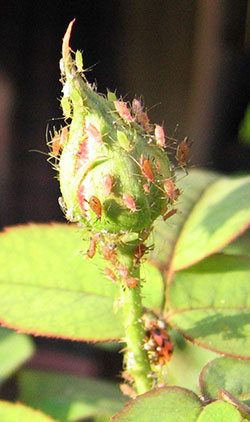The early bloom of roses makes them a popular landscape plant in Colorado. Because insects also enjoy the flowers, roses are rapidly becoming the victims of their own beauty. Look closely at the flowers for signs of attack:

- If flower buds are drilled with small holes, the weevil, rose curculio, could be the culprit. The weevil chews into buds to feed or lay eggs. Larvae gnaw the bloom as they develop, then drop to the ground to pupate. When disturbed, the curculio plays dead, dropping off the plant to avoid capture. Use this against them by knocking the bugs into a bowl of soapy water. Snip and remove infested flowers to keep larvae from developing.
- Droopy blooms, distorted flowers or buds failing to open are indications of rose midge. Insects slice young tissue around new leaves or buds. Midges emerge in April from the soil. They require less than four weeks to grow from egg to adult and five or more generations can develop over summer.
To control midge, clip off and destroy all infected buds, or treat with insecticides with the active ingredient imidicloprid. - Aphids are a yearly problem, coating plants in shiny, sticky honeydew. Look closely at buds and new growth for these soft-bodied insects.
A strong jet of water hoses them off the plant to the ground, where poor eyesight and broken legs prevent them from finding their way back again. Aphid infestations can be controlled with biorational insecticides such as insecticidal soap or neem oil. Insecticides including the active ingredients acephate, Imidacloprid, malation, esfenvalerate and cyfluthrin are also effective. - When mysterious brown flecks scar the flowers and leave them looking spent before they open, suspect thrips. These small insects feed
 on cells one by one, leaving a silver trail across the flower. Often confused with heat damage, roses may be deformed if thrips attack as the budfirst shows color. Check for thrips by tapping the bloom over a sheet of white paper. If the specks that fall start moving around, you have them. Deadhead flowers to remove thrips but serious cases may require spraying with insecticides with the active ingredient Spinosad, or imidicloprid.
on cells one by one, leaving a silver trail across the flower. Often confused with heat damage, roses may be deformed if thrips attack as the budfirst shows color. Check for thrips by tapping the bloom over a sheet of white paper. If the specks that fall start moving around, you have them. Deadhead flowers to remove thrips but serious cases may require spraying with insecticides with the active ingredient Spinosad, or imidicloprid.



